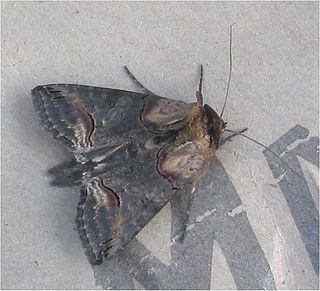Related Research Articles

Daphnis nerii, the oleander hawk-moth or army green moth, is a moth of the family Sphingidae. It was described by Carl Linnaeus in his 1758 10th edition of Systema Naturae.

Lasiommata megera, the wall or wall brown, is a butterfly in the family Nymphalidae. It is widespread in the Palearctic realm with a large variety of habitats and number of generations a year.

Hippotion celerio, the vine hawk-moth or silver-striped hawk-moth, is a moth of the family Sphingidae. It was described by Carl Linnaeus in his 1758 10th edition of Systema Naturae.

Abrostola triplasia is a moth of the family Noctuidae. It is found across the entire Palearctic realm. Subarctic territories with an average temperature of below 6 °C are an exception. In the warmest and driest regions of the Mediterranean, the Middle East, and the mountains in West and Central Asia, the species occurs only scattered or is entirely lacking.

Ematurga atomaria, the common heath, is a moth of the family Geometridae.

Palpita vitrealis, common name jasmine moth or white pearl, is a species of moth of the family Crambidae.

Parapoynx stratiotata, the ringed china-mark, is a moth of the family Crambidae. The species was first described by Carl Linnaeus in his 1758 10th edition of Systema Naturae. It is found in Europe where the distribution area extends in the north to the British Isles including Ireland and in the south to Sardinia, Sicily and Greece. The species is also found across the Palearctic in North Africa, Lebanon, Turkey, Azerbaijan, Kyrgyzstan, Uzbekistan and China..

Mythimna separata, the northern armyworm, oriental armyworm or rice ear-cutting caterpillar, is a moth of the family Noctuidae. It is found in China, Japan, South-east Asia, India, eastern Australia, New Zealand, and some Pacific islands. It is one of the major pests of maize in Asia. The species was first described by Francis Walker in 1865.

Brithys crini, the amaryllis borer, crinum borer, lily borer or Kew arches, is a moth of the family Noctuidae. It is a garden pest in parts of its range, as their larvae damage the stems and leaves of lilies, especially lilies of the family Amaryllidaceae.
Acrapex brunnea is a species of moth of the family Noctuidae first described by George Hampson in 1910. It is found in Africa, including Angola, Kenya and South Africa.
Acrapex carnea is a species of moth of the family Noctuidae first described by George Hampson in 1905. It is found in Africa, including South Africa.
Acrapex metaphaea is a species of moth of the family Noctuidae first described by George Hampson in 1910. It is found in Africa, including Zimbabwe and South Africa.
Acrapex spoliata is a species of moth of the family Noctuidae first described by Francis Walker in 1863. It is found in Africa, including Sierra Leone and South Africa.

Grapholita molesta, the oriental fruit moth or peach moth, is a moth of the family Tortricidae. It is native to China, but was introduced to Japan and North America and is now also found throughout of Europe, Asia and South America and in Hawaii, Morocco, Mauritius, South Africa, Australia and New Zealand

Condica capensis is a moth of the family Noctuidae. It is found across Africa, the Indian sub-continent and South-East Asia. In Europe, it is only common in southern Spain, but can be found further north.

Oraesia emarginata is a species of moth of the family Erebidae first described by Johan Christian Fabricius in 1794. It is found in Australia, New Caledonia, Indonesia, New Guinea, Pakistan, the Philippines, India, Sri Lanka, Sulawesi, Taiwan, China, Japan, Korea and Nepal as well as Eritrea, Ethiopia, Kenya, Namibia, Nigeria, South Africa, Tanzania, the Gambia, Uganda, Oman and Yemen.

Eublemma parva, the small marbled, is a moth of the family Erebidae. The species was first described by Jacob Hübner in 1808.
The 1960 New Zealand rugby union tour of South Africa, was a series of rugby union match played by New Zealand national rugby union team in South Africa and Rhodesia.

Nagia linteola is a species of moth in the family Erebidae first described by Achille Guenée in 1852. This species occurs in South Africa, the Democratic Republic of the Congo, Yemen, the Comoros, Mauritius, Madagascar, Indonesia (Borneo), India, Sri Lanka, Myanmar, Thailand and in Australia, where it has been recorded from Western Australia, the Northern Territory, Queensland and Victoria.
Udeoides muscosalis is a moth in the family Crambidae. It was described by George Hampson in 1913. It is found in Kenya and South Africa.
References
- ↑ www.afromoths.net
- ↑ Hampson, G. F. 1902. "The moths of South Africa (Part II)" - Annals of the South African Museum 2: page 302